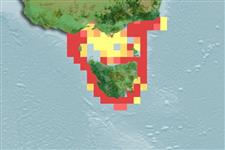Teleostei (teleosts) >
Gadiformes (Cods) >
Macrouridae (Grenadiers or rattails)
Etymology: Coelorinchus: Greek, koilos = a hollow + Greek, rhyngchos = jaw (Ref. 45335).
More on author: Richardson.
Environment: milieu / climate zone / depth range / distribution range
Ecology
Marine; benthopelagic; non-migratory; depth range 80 - 300 m (Ref. 1371). Temperate; 37°S - 47°S, 143°E - 152°E (Ref. 1371)
Indo-Pacific: endemic to Australia.
Size / Weight / Age
Maturity: Lm ? range ? - ? cm
Max length : 55.0 cm TL male/unsexed; (Ref. 1371)
Dorsal spines (total): 0; Anal spines: 0. Snout blunt, but not rounded, without a sharp rostral spine, its antero lateral margin incompletely supported by bone; chin barbel short. Head dark brown dorsally, with small pale spots. Body dark brownish with 8 or 9 pale longitudinal stripes. First dorsal fin tip black; anal fin with a blackish stripe posteriorly; the mouth and gill cavities blackish.
Generally demersal, on the continental shelf and upper slope (Ref. 9563). Feeds on octopods, fish, and decapod crustaceans.
Life cycle and mating behavior
Maturities | Reproduction | Spawnings | Egg(s) | Fecundities | Larvae
Cohen, D.M., T. Inada, T. Iwamoto and N. Scialabba, 1990. FAO species catalogue. Vol. 10. Gadiform fishes of the world (Order Gadiformes). An annotated and illustrated catalogue of cods, hakes, grenadiers and other gadiform fishes known to date. FAO Fish. Synop. 125(10). Rome: FAO. 442 p. (Ref. 1371)
IUCN Red List Status (Ref. 130435)
Threat to humans
Harmless
Human uses
Tools
Special reports
Download XML
Internet sources
Estimates based on models
Preferred temperature (Ref.
123201): 10.9 - 14.9, mean 12.2 °C (based on 13 cells).
Phylogenetic diversity index (Ref.
82804): PD
50 = 0.5000 [Uniqueness, from 0.5 = low to 2.0 = high].
Bayesian length-weight: a=0.00251 (0.00128 - 0.00492), b=3.19 (3.03 - 3.35), in cm total length, based on LWR estimates for this Genus-body shape (Ref.
93245).
Trophic level (Ref.
69278): 4.1 ±0.61 se; based on food items.
Resilience (Ref.
120179): Very Low, minimum population doubling time more than 14 years (Preliminary K or Fecundity.).
Fishing Vulnerability (Ref.
59153): Moderate vulnerability (42 of 100).
